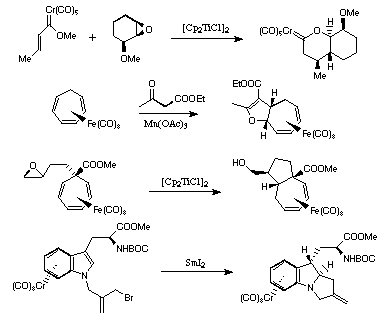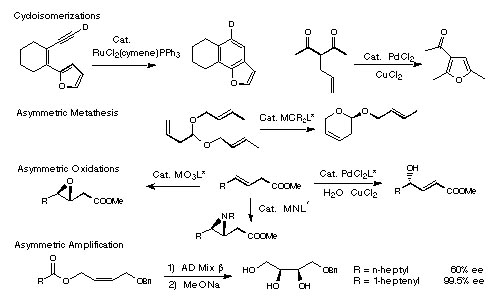The Merlic Research Group Interests
| Group Meeting Schedule |
Our research program in organic and organometallic chemistry encompasses synthetic organic, synthetic organometallic, and physical organometallic chemistry. Research goals include discovery of new reactions and catalysts, development of synthetic methods, new techniques for asymmetric synthesis, determination of reaction mechanisms, synthesis of bioactive natural products and development of organometallic complexes for materials research. The development of new chemistry using organometallic species is a rich and fertile area due to the unique ability of transition metal fragments to impart special reactivity, selectivity, and stability upon bonded organic moieties. Our research draws on these features to address problems in organic synthesis.
Organometallic Radical Reactions for Stereoselective Synthesis
Organometallic radical reactions are being investigated as new methods for carbon-carbon bond formation. By using transition metal fragments totemplate the reactions of organic moieties, control of chemoselectivity, regiochemistry and stereochemistry in radical cyclizations is feasible. A wide array of organometallic compounds are employed including iron olefin complexes, cobalt alkyne complexes, iron triene complexes, chromium carbene complexes and arene chromium complexes. The later are used for asymmetric synthesis where both enantiomers of a product are available from a single starting enantiomer. Applications of the newly developed methods to the syntheses of biologically active products such as antitumor agents, unnatural sugars, and antibiotics are under investigation.

Synthesis Via Metal-Mediated Pericyclic Reactions and Fischer Carbene Complexes
We are exploring fundamentally new types of pericyclic reactions by incorporating metal fragments into reacting polyene arrays. The metals can participate directly in pericyclic reactions or can serve as templates to control reaction selectivity. Examples include a variety of annulations employing chromium carbene complexes, while second generation reactions will employ metal fragments catalytically. Topics we seek to address in organometallic pericyclic reactions include reaction mechanisms, selectivity rules, substrate variability and synthetic applications. These new methods are being applied in the synthesis of a number of structurally diverse antibiotic, antiimflammatory and antitumor agents.

Asymmetric Synthesis and Catalysis
While stoichiometric implementation of transition metal organometallic chemistry provides for unique molecular transformations, the real power of transition metal complexes lies in catalysis. Single catalytic reactions can replace multiple steps in traditional organic synthesis and do so with lower costs in an environmentally friendly manner. Catalysts are under investigation for precesses including asymmetric synthesis, carbon-heteroatom bond formation, multicomponent coupling, cycloisomerizations and pericyclic reactions. Most of these focus on the use of homogeneous palladium and ruthenium catalysis. New methods of catalyst immobilization that facilitate recycling and reuse are also being explored.
